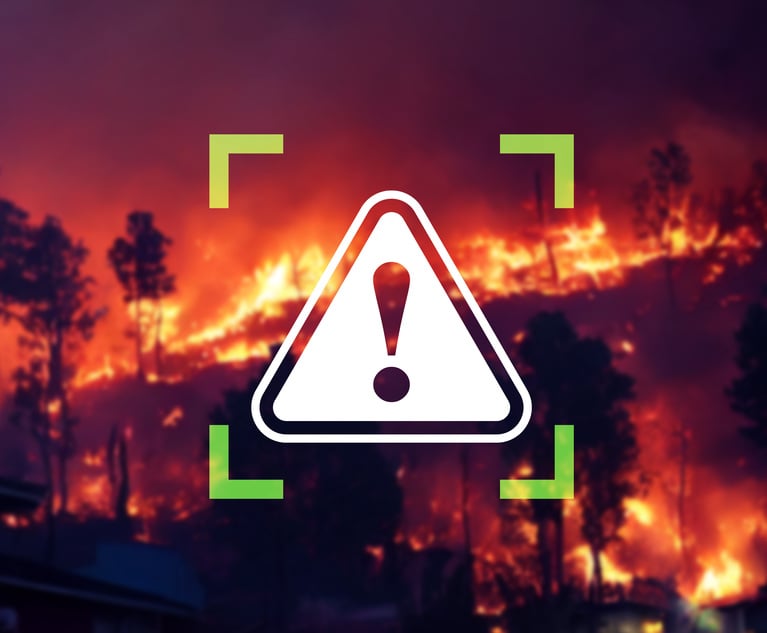Looking to avoid a public relations debacle like the one thatstill haunts the industry over Hurricane Katrina claims, insurergroups briefed Congressional staffers last week on their swiftresponse to October's California wildfires. The battle for publicopinion might still be uphill, however, with at least one majornewspaper reporting widespread underinsurance.
|On the same day insurance industry leaders met in Washington totrumpet their wildfire performance, a New York Times story reportedthat "as many as 40 percent of homeowners statewide lack enoughinsurance to cover their home-replacement costs," citing CaliforniaDepartment of Insurance statistics.
|In that story, the state's former insurance commissioner andlongtime critic, California Lt. Gov. John Garamendi, said hebelieves insurers are at fault.
|On Capitol Hill, the heads of the major insurance company groupsspoke of the industry's swift response and the sacrifices made byinsurance professionals to help policyholders begin rebuilding.
|Insurance Information Institute President Robert P. Hartwignoted that although the fires were indeed a disaster, with anestimated insured loss of $1.6 billion, the catastrophe involvedwas relatively small in comparison with what the industry has dealtwith before. "It is within the realm of expectation," he said.
|While the estimated loss would make this the second mostexpensive fire disaster in recent history, Mr. Hartwig noted thatfires accounted for only 2.2 percent of catastrophe losses duringthe past 20 years, and that the October fires was not among eventhe top-10 most expensive U.S. catastrophes overall.
|Furthermore, California is a strong market for homeownersinsurance, he said, with rate decreases having been filed andapproved for most major insurers.
|Additionally, Mr. Hartwig noted the state's insurer of lastresort, the FAIR Plan, covers only 1-to-1.5 percent of the market,and the number of FAIR Plan policies has been shrinking inhigh-risk areas as private insurers offer coverage.
|Marc Racicot, president and chief executive officer of theAmerican Insurance Association, said the state's second-largestinsurer, Farmers, had numerous agents and adjusters, a mobileclaims center "and even its CEO on the scene."
|He said other companies have gone beyond their legalrequirements to pay claims. Employees at Safeco donated $250,000 tohelp the rebuilding effort, and Fireman's Fund has said it willoffer policyholders the choice to rebuild their homes in a moreenvironmentally friendly way at no extra cost, he noted.
|Mr. Racicot also said The Hartford announced it will not cancelpolicies for lapses due to the fires. "Helping others is why theinsurance industry exists," he said.
|David Sampson, president and CEO of the Property CasualtyInsurers Association of America, said homeowners should not beconcerned their filing of a claim will make their insurer morelikely to nonrenew them.
|Since earlier fires, the state has enacted a law barringinsurers from cancelling a policy prior to reconstruction andrequires a renewal offer be made following a disaster.
|Additionally, Mr. Racicot said insurers will pay replacementcosts to rebuild a home without deduction for physicaldepreciation, and under the state of emergency declaration by Gov.Arnold Schwarzenegger, insurers will provide coverage for livingexpenses for up to two years.
|"It is during these times of tragic loss that the value of ourindustry and the financial safety net we provide consumers,businesses and local economies becomes clear," he said.
|National Association of Mutual Insurance Companies PresidentChuck Chamness spoke of the ground-level work done by insurancecompany employees to help clients, including an agent that "cutshort a once-in-a-lifetime trip to Jerusalem."
|He mentioned another he said had donated their RV so thepolicyholders of a smaller company would have a place to meet andwork with their agent.
|The insurance industry, he said, is working to fund researchthat will lead to better, more secure homes to help avoid disastersin the future. "The science underwritten by the insurance industrynow will help everyone understand how to avoid more damages later,"he said.
|However, spoiling the mood was the Nov. 13 Times article, whichhighlighted the stories of two families whose homes were destroyedby the fires and are now facing steep construction costs that mayoutpace their insurance policy limits--on top of the realizationthat they lacked coverage for the contents of their homes.
|Mr. Garamendi was mentioned as among those who blame insurersfor the widespread insufficient coverage. The article mentionedcomments he made earlier this year decrying the "lack of clarity"in policy language, and his belief that in some cases insurers andtheir agents "were giving bad information to the consumers."
|At an Oct. 24 press conference with Gov. Schwarzenegger, Lt.Gov. Garamendi said the state would keep its eye on the industry.In the aftermath of the fires, he said, "rebuilding mechanisms"were in place "with the insurance industry playing its appropriaterole, and the state watching carefully that they do so."
|Mr. Hartwig told the Times the idea that insurers areresponsible for the problem "is a figment of John Garamendi'spolitical imagination," adding there is no evidence to support theargument and "no report from any state agency that suggests that'sthe case."
Want to continue reading?
Become a Free PropertyCasualty360 Digital Reader
Your access to unlimited PropertyCasualty360 content isn’t changing.
Once you are an ALM digital member, you’ll receive:
- All PropertyCasualty360.com news coverage, best practices, and in-depth analysis.
- Educational webcasts, resources from industry leaders, and informative newsletters.
- Other award-winning websites including BenefitsPRO.com and ThinkAdvisor.com.
Already have an account? Sign In
© 2024 ALM Global, LLC, All Rights Reserved. Request academic re-use from www.copyright.com. All other uses, submit a request to [email protected]. For more information visit Asset & Logo Licensing.








